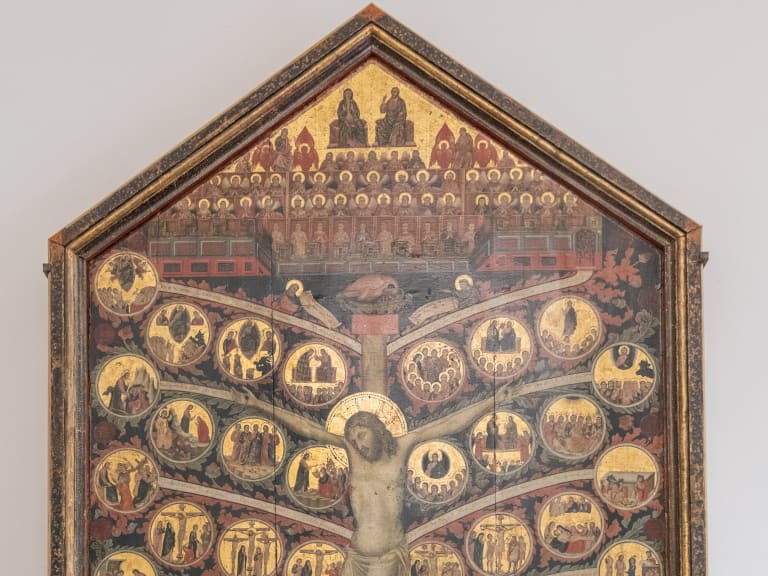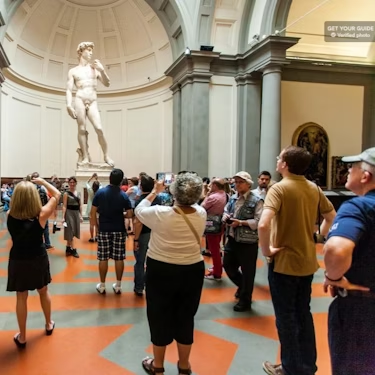More about: 10 Best Paintings at the Accademia Gallery in Florence
The Accademia Gallery is an essential visit on your trip to Florence. In this museum you will find the 'David', Michelangelo's work par excellence, but you will also be able to see other sculptures by authors such as Lorenzo Bartolini, Luis Pampaloni or Juan de Bolonia, as well as paintings by great artists such as Sandro Botticelli, Filippino Lippi, Alessandro Allori or Bernardo Daddi. Here is a list of all the essential things you must see with your tickets to the Galleria dell'Accademia.
1. David', by Michelangelo

The Galleria dell'Accademia is home to the most famous statue in the world: Michelangelo's David. An extraordinary large-scale sculpture created in the early 16th century that reflects the Renaissance artist's great knowledge of human anatomy and the male body. Made of white marble, this statue represents the biblical hero before battle and conveys certain sensations such as security and concentration. In addition, various details are perfectly defined, such as the veins on the back of the hands and the flexing of the muscles in the right leg.
The large dimensions of some of the parts of Michelangelo's work have been interpreted because the statue was originally intended to be placed on the roof line of the cathedral and, in this way, it was the only way it would be visible from the ground.
The large size of the head and the imposing right hand stand out. This statue was located in the Piazza della Signoria until 1873, when it was moved to the Accademia Gallery to protect it from external conditions.
- Tip: If you have time and want to learn more about this majestic work, I recommend you book a guided tour of the Galleria dell'Accademia and Michelangelo's David, and have an expert guide tell you facts and curiosities.
2. Michelangelo's 'The Slaves

In the corridor leading to the David, there are four imposing statues sculpted by Michelangelo between 1519 and 1534, the Prisoners or Slaves. These four nude male figures (the Young Slave, the Awakening Slave, the Bearded Slave and the Atlantean Slave) in which, once again, Michelangelo showed his extensive knowledge of human anatomy in the definition of the muscles and other features, were initiated for a very specific project, the tomb of Pope Julius II, which, in the end, did not see the light of day.
The Prisoners or Slaves were not finished by the great artist and, after his death, his nephew donated them to the Grand Duke Cosimo I Medici. They were later placed in the corners of the Grotta Grande in the Boboli Gardens, where they remained until the first decade of the 20th century, when they were moved to the Accademia.
3. The Rape of the Sabine Women', by Juan de Bolonia

Located in the centre of the Sala del Coloso is the 'Rape of the Sabine Women' by Juan de Bolonia, dating from 1579 and 1580. This sculpture, 410 cm high, represents three naked figures: a young man who lifts up a woman who is trying to struggle to escape, and on the young man's legs is a man with desperate features. In fact, it is also known as The Three Ages of Man. The figures are united both by their gazes and by their bodies.
4. Venus and Cupid', by Jacopo da Pontormo

Based on Michelangelo's drawings, 'Venus and Cupid' is a painting by Jacopo Carucci, also known as Jacopo da Pontormo, dating from 1533. The Mannerist painter and portraitist depicts in the painting the contrast between earthly love, represented by the young Cupid, and spiritual love, reflected by the goddess Venus. Painted in oil on panel, the painting measures 128 cm by 194 cm.
5. Madonna and Child, St. John and the two angels', by Sandro Botticelli

This work by Sandro Botticelli, which dates from 1468, depicts the Virgin and Child together with two angels and Saint John the Baptist. It is notable for its use of very bright colours. On display in the Galleria dell'Accademia since 1919, it was previously located in the Hospital of Santa Maria Nuova. It is not known by whom it was commissioned or its original location. Small in format, 98 x 97 cm, it has been restored on a couple of occasions since the 20th century, specifically in 1979 and 2011.
6. The Tree of Life, by Pacino di Buonaguida

This painting, measuring 248 by 170 cm, by Pacino di Buonaguida, is based on the Book of Genesis. In the work, which dates from the early 14th century, the crucified Christ is depicted as a tree with various branches extending from his body. From each branch of the tree hang a kind of medal decorated with biblical events.
7. Saint Matthew by Michelangelo

The 271 cm statue of Saint Matthew was commissioned by Michelangelo to sculpt the twelve apostles for the Cathedral of Florence. The commission never came to fruition and the only statue that the artist began to sculpt was the statue of Saint Matthew, although it is thought that he continued to work on this statue at a later date. The inscription on the base states that this statue was moved from the courtyard of the Opera del Duomo in Florence to the Academy of Fine Arts in 1831. Later, in 1909, it was moved to the Galleria dell'Accademia.
8. Painted Cross with the Madonna and St. John by Bernardo Daddi

A pupil of Giotto, Bernardo Daddi was an acclaimed and brilliant painter and the Painted Cross with the Virgin and Saint John is one of his most important works. It was executed between 1340 and 1345 for the Monastery of San Donato, but was subsequently transferred to the Uffizi Gallery in the second half of the 19th century and in 1919 it reached the Galleria dell'Accademia. The crown of Christ, made of gilded plaster, is particularly noteworthy.
9. Museum of Musical Instruments

The Accademia Gallery has a collection of almost fifty antique musical instruments, including pieces by Antonio Stradivari and Bartolomeo Cristofori. Known as the Museum of Musical Instruments, they come from the private collections of the Grand Dukes of Tuscany and the Medici family. The Gallery also has a multimedia system in this room that will allow you to immerse yourself in an immersive experience.
10. Bartolini Gallery

The Gipsoteca Bartolini reflects the origins of the museum as a place of learning and is a reflection of the life of the sculptor Lorenzo Bartolini, who was a teacher at the institution from 1839. The room houses a large collection of sculptures made in plaster by both Bartolini and Pampaloni, one of his pupils.
Some of Bartolini's sculptures that you can see in the Galleria dell'Accademia are Ammostatore, Arnina, Emma and Julia Campbell, Figura allegorica per il monumento Demidov, Medalla per il monumento a Gerolamo Segato, Monumento a Elisa Baciocchi or Ninfa dello Scorpione, among others.
The Galleria dell'Accademia in Florence room by room

The Accademia Gallery has two floors which are divided into a series of rooms:
- Hall of the Colossus: It houses 15th century paintings by artists such as Botticelli, Domenico Ghirlandaio, Paolo Uccello, Filippino Lippi or Perugino.
- Gallery of the Prisoners: The four prisoners stand out, as well as important 16th century paintings by artists such as Andrea del Sarto, Granacci, Pontormo, Fra' Bartolomeo and Michele di Ridolfo del Ghirlandaio.
- The Tribune: This is the busiest area of the museum and houses Michelangelo's David.
- Gipsoteca: Room dedicated to Florentine sculptures from neoclassicism to romanticism. It houses a large collection of plaster sculptures by Bartolini and Pampaloni.
- Sala di Pacino, Sala di Giotto e Giotteschi and Sala degli Orcagna: These three rooms house paintings from the 13th and 14th centuries.
- Museum of Musical Instruments.
- Rooms of Lorenzo Monaco and the late Gothic: with 15th century paintings.
Recommendations to see the best works of the Galleria dell'Accademia without crowds

On your visit to the Galleria dell'Accademia keep in mind the following tips to make your visit as pleasant as possible:
- Buy your ticket in advance: The Accademia Gallery is one of the most visited museums in Florence. Therefore, I recommend that you book your ticket in advance to avoid wasting time at the ticket office. In addition, it is also possible to buy a ticket with priority access. The cheapest tickets for the Accademia are priced from £26 at Hellotickets 26
- Check the map: Before starting your visit to the Accademia Gallery it is advisable to check the map of the museum and get an idea of where each room is and what you can see in each of them.
- Go early in the morning: The Galleria dell'Accademia is one of the most visited museums in Florence. For this reason, I recommend that you go during the week and early in the morning or late in the afternoon so that you don't come across so many tourists and you can make the visit in a more relaxed way.
- The Accademia Gallery does not have a cloakroom, so bags, suitcases and large backpacks are not allowed.
- Mineral water bottles are allowed, as long as they do not exceed half a litre in capacity.
- You will have to go through a security check when you enter, so allow for this in the total time of your visit.
- Take as much time as you need to see the different works.
And after exploring the Accademia Gallery, keep in mind that you can visit the Uffizi Gallery or the Leonardo da Vinci Museum. I advise you to check out the best museums in Florence and plan a trip of 10.




